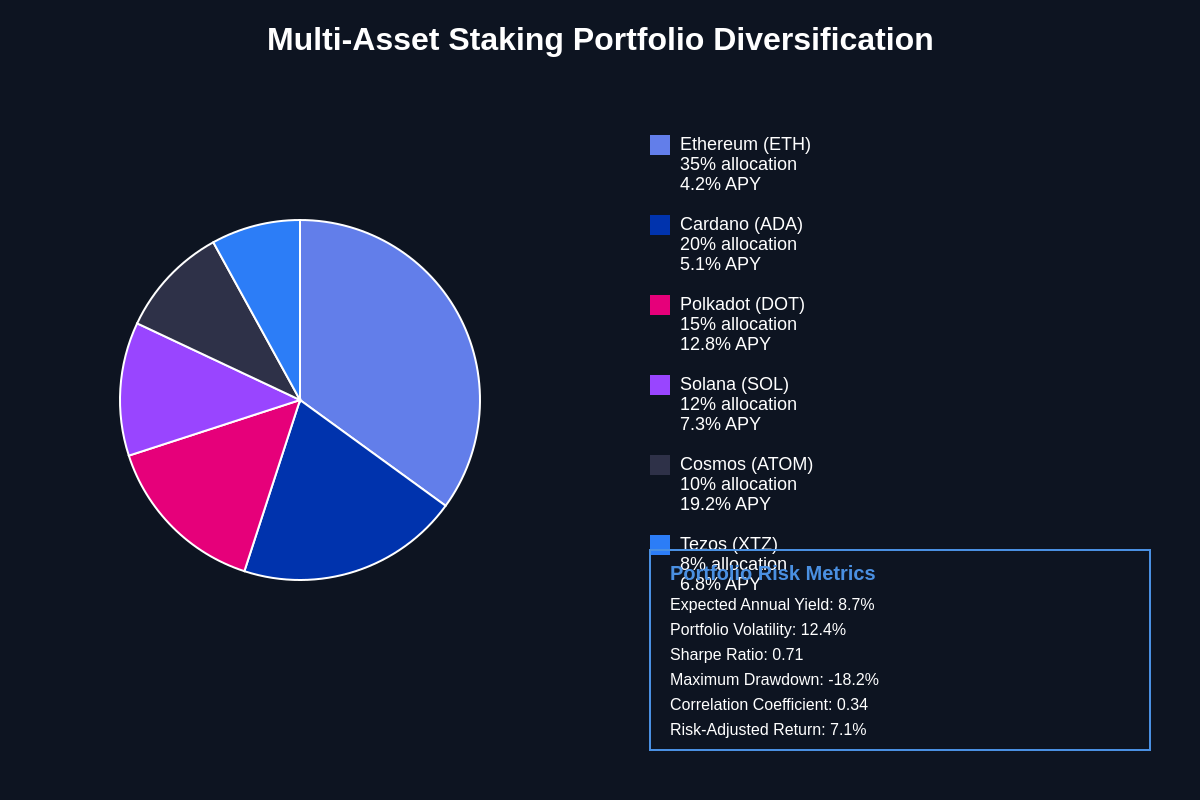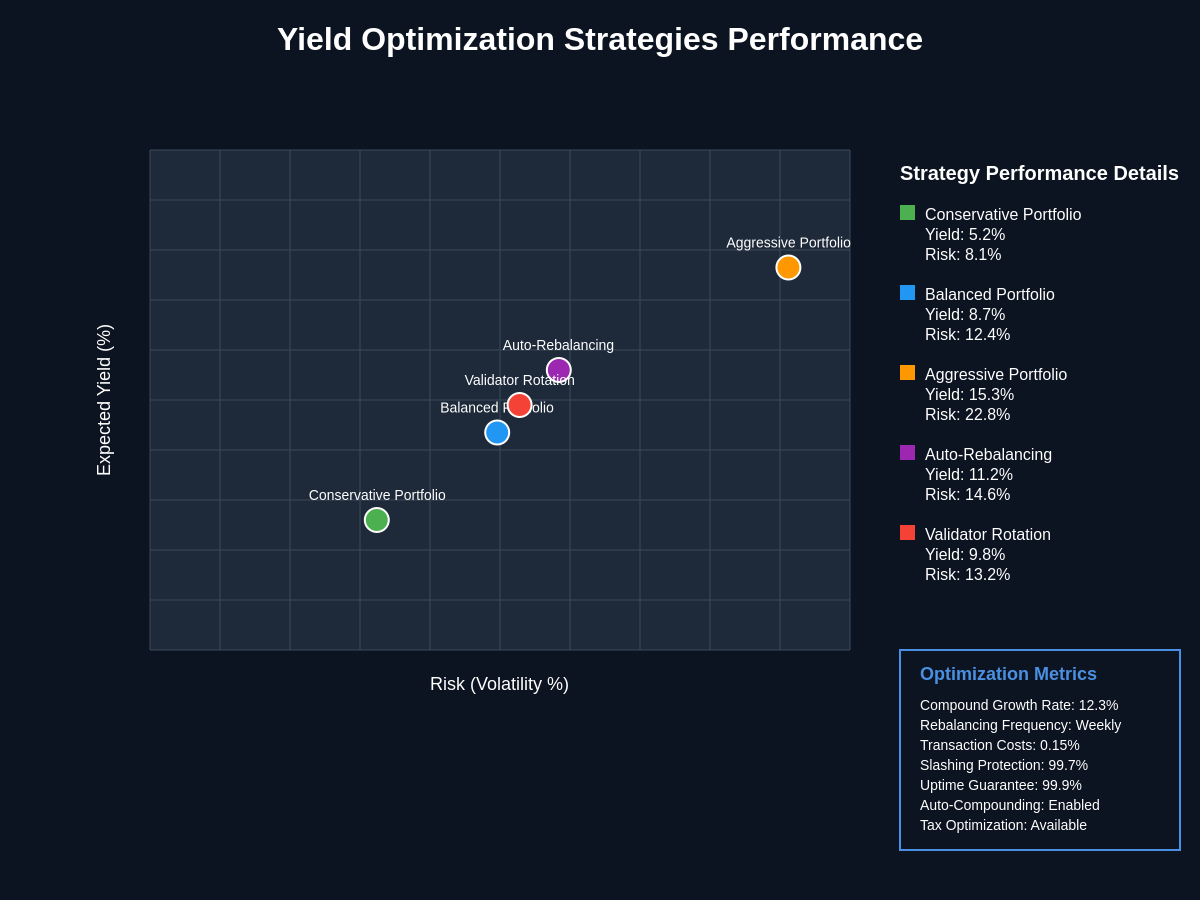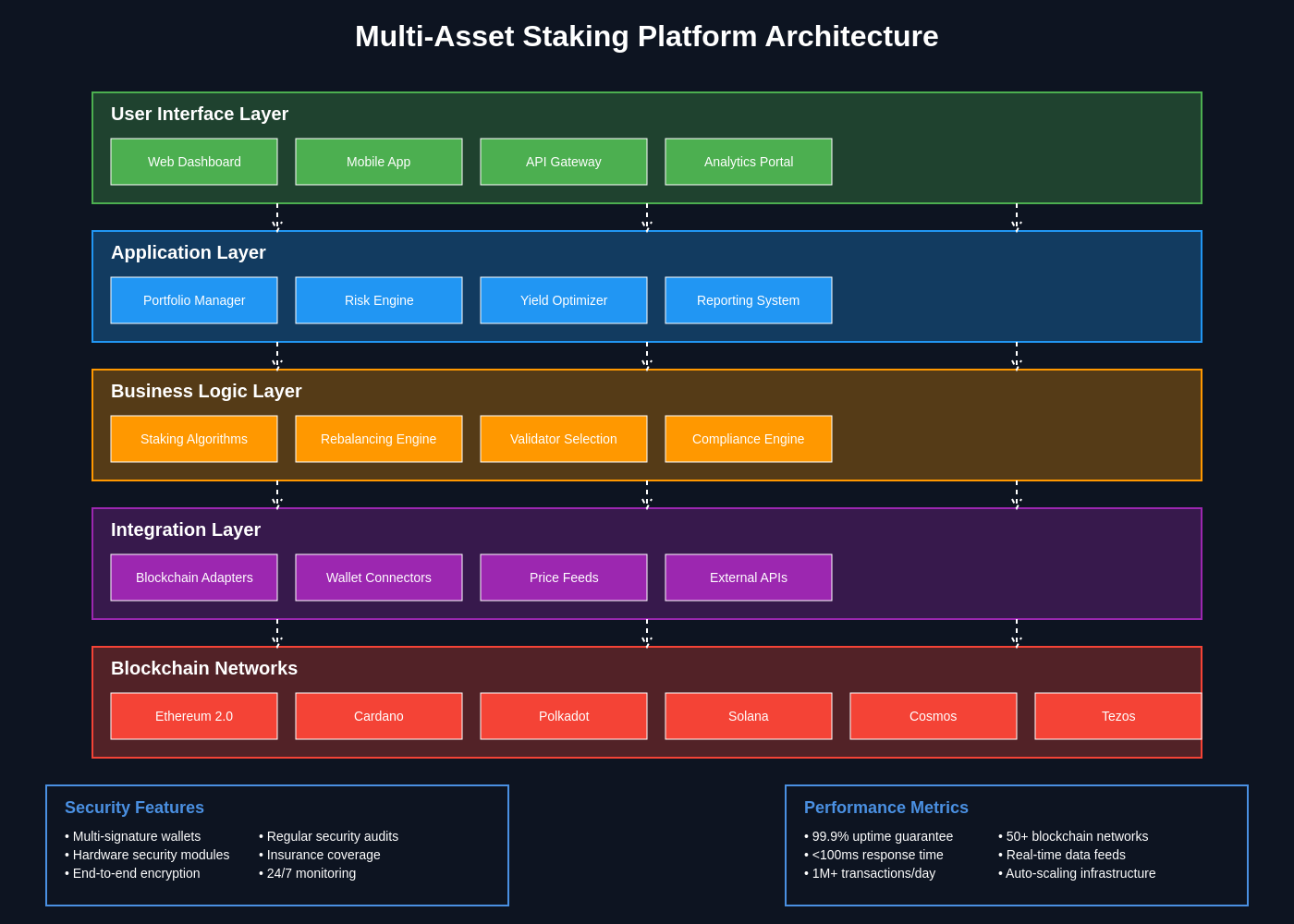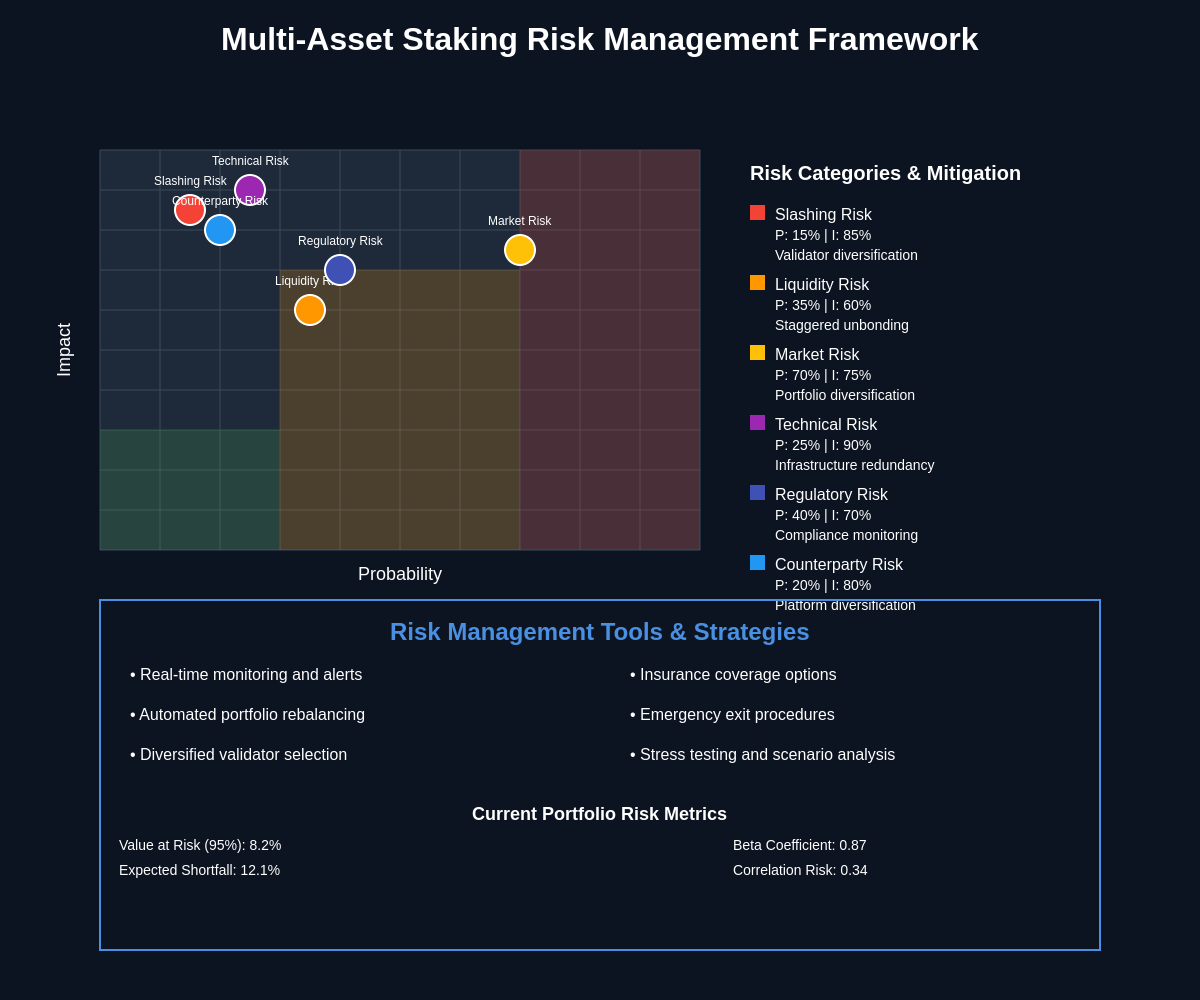TradingView Pine Script Reference
The Evolution of Multi-Asset Staking Ecosystems
The cryptocurrency landscape has witnessed a revolutionary transformation in yield generation strategies through the emergence of sophisticated multi-asset staking platforms that enable investors to diversify their holdings across multiple blockchain networks while earning rewards from various consensus mechanisms simultaneously. These platforms represent a significant evolution from single-asset staking models, offering institutional-grade portfolio management tools that optimize returns across different risk profiles, staking mechanisms, and validator networks to maximize yield potential while minimizing exposure to individual network risks.
Multi-asset staking platforms have fundamentally changed how investors approach cryptocurrency portfolio management by providing unified interfaces for managing staking positions across diverse blockchain ecosystems including Ethereum, Cardano, Polkadot, Solana, Cosmos, and numerous other proof-of-stake networks. The sophistication of these platforms extends beyond simple staking aggregation to include advanced features such as automated rebalancing, yield optimization algorithms, risk assessment tools, and comprehensive analytics that provide investors with deep insights into their staking performance across multiple networks.

The technological infrastructure underlying these platforms represents a complex integration of blockchain protocols, smart contract systems, and sophisticated middleware that enables seamless interaction with multiple staking networks while maintaining security, transparency, and efficiency. These systems must navigate the unique characteristics of each blockchain network, including different staking mechanisms, reward distribution models, slashing conditions, and validator selection criteria, while providing users with simplified interfaces that abstract away the technical complexity of multi-network staking operations.
Understanding Diversified Staking Strategies
Diversified staking strategies encompass a broad range of approaches designed to optimize yield generation while managing risk through strategic allocation across different blockchain networks, staking mechanisms, and validator pools. These strategies recognize that different blockchain networks offer varying risk-reward profiles based on factors such as network maturity, validator reliability, token economics, governance mechanisms, and market dynamics that collectively influence staking returns and associated risks.
The fundamental principle underlying diversified staking strategies involves spreading staking positions across multiple networks to reduce concentration risk while capturing yield opportunities from different blockchain ecosystems. This approach acknowledges that individual networks may experience periods of reduced rewards due to factors such as network upgrades, validator issues, governance disputes, or market conditions, making diversification essential for maintaining consistent yield generation over time.
Professional staking strategies incorporate sophisticated risk management techniques including correlation analysis between different networks, historical performance evaluation, validator scoring systems, and dynamic allocation models that adjust portfolio composition based on changing market conditions and network performance metrics. These strategies often employ quantitative models that analyze factors such as staking yields, network security, token volatility, and liquidity conditions to optimize allocation decisions across different staking opportunities.
The integration of TradingView’s advanced charting tools enables stakers to perform comprehensive technical analysis of staking rewards and network performance across multiple blockchain ecosystems, providing valuable insights for optimizing diversified staking strategies. Advanced staking platforms increasingly incorporate these analytical capabilities to help users make informed decisions about asset allocation and validator selection across different networks.

Platform Architecture and Infrastructure
Multi-asset staking platforms employ sophisticated architectural frameworks that must seamlessly integrate with diverse blockchain networks while maintaining high levels of security, performance, and reliability. These systems typically utilize modular architectures that can accommodate the unique characteristics of different blockchain protocols while providing unified user experiences and comprehensive portfolio management capabilities across multiple staking environments.
The core infrastructure of leading multi-asset staking platforms incorporates advanced validator selection algorithms that continuously monitor validator performance across different networks, analyzing factors such as uptime, commission rates, slashing history, and delegation patterns to optimize staking allocations. These systems employ real-time monitoring capabilities that track validator performance metrics and automatically adjust staking positions to maintain optimal yield generation while minimizing exposure to underperforming validators.
Smart contract integration represents a critical component of multi-asset staking platform architecture, enabling automated execution of staking operations, reward distribution, and portfolio rebalancing across multiple blockchain networks. These smart contracts must be carefully designed to handle the complexities of cross-chain operations while maintaining security and efficiency, often incorporating multi-signature requirements, time-locked operations, and comprehensive audit trails to ensure secure operation.
The user interface and experience design of multi-asset staking platforms must balance comprehensive functionality with intuitive operation, providing both novice and professional users with appropriate tools for managing complex staking portfolios. Advanced platforms incorporate sophisticated dashboard systems that provide real-time portfolio performance metrics, risk assessments, yield projections, and detailed analytics that enable users to make informed decisions about their staking strategies.

Risk Management in Multi-Asset Staking
Effective risk management in multi-asset staking environments requires comprehensive understanding of the diverse risk factors associated with different blockchain networks, staking mechanisms, and validator ecosystems. These risks include technical risks such as slashing penalties, network downtime, and smart contract vulnerabilities, as well as market risks including token price volatility, liquidity constraints, and correlation effects between different staking assets.
Slashing risk represents one of the most significant concerns in multi-asset staking strategies, as different blockchain networks implement varying penalty mechanisms for validator misbehavior or network protocol violations. Professional staking platforms implement sophisticated slashing risk assessment tools that evaluate validator reliability, historical performance, and network-specific slashing conditions to minimize exposure to potential penalties while maintaining competitive staking yields across different networks.
Liquidity risk management becomes increasingly complex in multi-asset staking environments due to varying unbonding periods, withdrawal restrictions, and market liquidity conditions across different blockchain networks. Advanced staking platforms address these challenges through intelligent liquidity management systems that maintain appropriate reserves across different networks while optimizing capital efficiency and ensuring users can access their funds when needed.
The correlation analysis between different staking assets plays a crucial role in portfolio risk management, as assets that appear diversified may exhibit high correlation during market stress periods, reducing the effectiveness of diversification strategies. Sophisticated risk management systems continuously monitor correlation patterns between different staking assets and adjust portfolio allocations to maintain true diversification benefits across varying market conditions.
TradingView’s risk management indicators provide valuable tools for analyzing volatility patterns and correlation relationships between different staking assets, enabling more informed risk management decisions in multi-asset staking portfolios.

Yield Optimization Techniques
Yield optimization in multi-asset staking platforms involves sophisticated algorithms and strategies designed to maximize returns across diverse staking opportunities while maintaining appropriate risk levels and liquidity requirements. These techniques incorporate real-time analysis of staking yields, network conditions, validator performance, and market dynamics to continuously optimize portfolio allocations and maximize compound growth potential.
Dynamic rebalancing strategies represent a cornerstone of yield optimization in multi-asset staking environments, automatically adjusting portfolio allocations based on changing yield differentials, risk assessments, and market conditions across different blockchain networks. These systems employ advanced algorithms that consider factors such as transaction costs, unbonding periods, and opportunity costs when making rebalancing decisions to ensure that optimization activities generate net positive returns.
Compound yield strategies maximize the power of reinvestment by automatically compounding staking rewards across multiple networks, often employing sophisticated timing algorithms that optimize the frequency and allocation of reward reinvestment to maximize long-term growth potential. These strategies must carefully balance the benefits of frequent compounding against transaction costs and operational complexity to ensure optimal net returns.
Auto-delegation and validator rotation strategies enhance yield optimization by continuously monitoring validator performance across different networks and automatically reallocating stakes to higher-performing validators when beneficial. These systems employ comprehensive validator scoring algorithms that consider multiple performance metrics and historical data to make informed delegation decisions that optimize long-term staking returns.
The integration of artificial intelligence and machine learning technologies in yield optimization systems enables increasingly sophisticated analysis of market conditions, network dynamics, and performance patterns to predict optimal allocation strategies and timing decisions. These systems can identify subtle patterns and correlations that may not be apparent through traditional analysis methods, potentially enhancing yield generation capabilities.
Institutional Adoption and Professional Services
The institutional adoption of multi-asset staking platforms has accelerated significantly as professional investment managers, pension funds, and corporate treasuries recognize the potential for generating consistent yields through diversified staking strategies. These institutional users require sophisticated tools, comprehensive reporting capabilities, and institutional-grade security measures that go beyond the needs of individual retail stakers.
Professional staking services for institutional clients typically include dedicated account management, customized reporting solutions, compliance monitoring, and specialized risk management tools designed to meet the specific requirements of institutional investment mandates. These services often incorporate advanced analytics, performance attribution analysis, and comprehensive audit trails that enable institutional investors to meet their fiduciary responsibilities while participating in staking opportunities.
Custody solutions for institutional multi-asset staking represent a critical infrastructure component that must balance security requirements with operational efficiency. Leading platforms employ institutional-grade custody solutions that include multi-signature security, hardware security modules, comprehensive insurance coverage, and segregated client assets to meet the stringent security and regulatory requirements of institutional investors.
The regulatory compliance aspects of institutional multi-asset staking continue to evolve as regulators worldwide develop frameworks for cryptocurrency staking activities. Professional platforms must navigate complex regulatory requirements across multiple jurisdictions while providing institutional clients with the compliance tools and reporting capabilities necessary to meet their regulatory obligations.
Technology Integration and API Development
Advanced multi-asset staking platforms provide comprehensive API solutions that enable institutional users, developers, and third-party applications to integrate staking functionality into their existing systems and workflows. These APIs must support complex operations across multiple blockchain networks while maintaining security, reliability, and performance standards required for professional applications.
The development of standardized APIs for multi-asset staking operations represents an important advancement in platform interoperability, enabling users to manage staking positions across different platforms through unified interfaces. These standardization efforts help reduce integration complexity while improving the overall user experience for sophisticated staking strategies that may involve multiple platform providers.
Real-time data integration capabilities enable multi-asset staking platforms to provide users with up-to-the-minute information about staking yields, validator performance, network conditions, and market dynamics across all supported blockchain networks. These systems must efficiently process and analyze vast amounts of data from multiple sources while providing users with actionable insights for optimizing their staking strategies.
The integration of advanced analytics and business intelligence tools enables multi-asset staking platforms to provide users with sophisticated performance analysis, risk assessment, and optimization recommendations. These tools often incorporate machine learning algorithms that can identify patterns and trends across multiple networks and time periods to provide predictive insights for staking strategy optimization.
Regulatory Landscape and Compliance Considerations
The regulatory environment surrounding multi-asset staking platforms continues to evolve as governments and regulatory agencies worldwide develop frameworks for overseeing cryptocurrency staking activities. These regulatory developments have significant implications for platform operators, service providers, and users, particularly in areas such as tax reporting, securities regulations, and anti-money laundering compliance.
Tax implications of multi-asset staking vary significantly across different jurisdictions, with some treating staking rewards as immediate taxable income while others apply capital gains treatment or provide specific exemptions for certain types of staking activities. Professional staking platforms increasingly provide comprehensive tax reporting tools that help users track their staking activities across multiple networks and generate the documentation necessary for accurate tax compliance.
Securities regulation represents another complex area for multi-asset staking platforms, as regulatory agencies examine whether certain staking tokens or staking-related products may be classified as securities under existing regulatory frameworks. Platform operators must carefully navigate these regulatory considerations while providing users with appropriate disclosures and compliance support.
The implementation of anti-money laundering and know-your-customer requirements for staking platforms varies across jurisdictions but generally requires comprehensive customer verification, transaction monitoring, and suspicious activity reporting. Leading platforms employ sophisticated compliance management systems that automate many of these requirements while ensuring full regulatory compliance across all supported jurisdictions.
Market Dynamics and Competitive Landscape
The multi-asset staking platform market has experienced rapid growth and evolution, with numerous platforms competing to provide the most comprehensive, efficient, and user-friendly staking solutions. This competitive environment has driven significant innovation in platform capabilities, user experience design, and integration technologies while generally benefiting users through improved services and competitive pricing.
Market differentiation among multi-asset staking platforms often focuses on factors such as the breadth of supported blockchain networks, sophistication of optimization algorithms, quality of user interfaces, level of customer support, and institutional service capabilities. Leading platforms continue to expand their supported networks and enhance their technological capabilities to maintain competitive advantages in this rapidly evolving market.
The emergence of decentralized staking protocols represents an important trend in the multi-asset staking space, offering users greater control over their staking activities while potentially reducing counterparty risks associated with centralized platform providers. These decentralized solutions often employ sophisticated smart contract systems that enable automated staking operations across multiple networks without requiring users to trust centralized operators.
Partnership and integration strategies play increasingly important roles in the competitive landscape, with platforms forming strategic alliances with wallet providers, institutional custody solutions, tax software providers, and other cryptocurrency infrastructure companies to provide comprehensive staking ecosystems. These partnerships enable platforms to offer more complete solutions while focusing on their core staking capabilities.
TradingView’s market analysis tools provide valuable insights into the performance and trends across different staking assets and platforms, helping users make informed decisions about platform selection and asset allocation strategies.
Future Developments and Innovation Trends
The future of multi-asset staking platforms promises continued innovation in areas such as cross-chain interoperability, artificial intelligence integration, and automated strategy optimization. These developments will likely enhance the sophistication and effectiveness of multi-asset staking strategies while making these tools more accessible to a broader range of users.
Cross-chain bridge integration represents a significant opportunity for multi-asset staking platforms to provide more seamless asset movement and optimization across different blockchain networks. Advanced bridge technologies may enable more efficient rebalancing strategies and reduce the friction associated with managing staking positions across multiple networks.
The integration of decentralized finance protocols with multi-asset staking platforms opens new possibilities for yield optimization and risk management. These integrations may enable sophisticated strategies that combine staking yields with lending, trading, and other DeFi activities to maximize returns while maintaining appropriate risk levels.
Artificial intelligence and machine learning technologies continue to advance the sophistication of staking optimization algorithms, potentially enabling more accurate prediction of optimal allocation strategies and timing decisions. These technologies may also enhance risk management capabilities and provide more personalized staking recommendations based on individual user preferences and risk tolerance.
The development of standardized protocols and interfaces for multi-asset staking may improve interoperability between different platforms and reduce the technical barriers to entry for new platform providers. These standardization efforts could accelerate innovation and competition in the multi-asset staking space while benefiting users through improved functionality and reduced costs.
Conclusion and Strategic Outlook
Multi-asset staking platforms represent a significant evolution in cryptocurrency yield generation strategies, providing sophisticated tools for diversified portfolio management across multiple blockchain networks. These platforms have democratized access to professional-grade staking strategies while continuously innovating to meet the evolving needs of both individual and institutional users.
The continued maturation of blockchain networks and staking mechanisms will likely provide new opportunities for yield generation and portfolio diversification through multi-asset staking strategies. Platform providers that can effectively navigate the technical, regulatory, and competitive challenges while providing superior user experiences and optimization capabilities will be best positioned to capture these opportunities.
The integration of advanced technologies such as artificial intelligence, cross-chain protocols, and decentralized finance capabilities will continue to enhance the sophistication and effectiveness of multi-asset staking platforms. Users who understand these developments and can effectively utilize these advanced capabilities will be better positioned to optimize their staking strategies and achieve their yield generation objectives.
The regulatory landscape will continue to evolve and mature, potentially providing greater clarity and stability for multi-asset staking platforms and their users. Platform providers and users who proactively address regulatory requirements and maintain compliance with evolving standards will be better positioned for long-term success in this dynamic market environment.
TradingView Pine Script Reference
Disclaimer: This article is for informational purposes only and does not constitute financial advice. Cryptocurrency staking involves risks including potential loss of principal, slashing penalties, and market volatility. Past performance does not guarantee future results. Always conduct your own research and consider consulting with a qualified financial advisor before making investment decisions. Staking rewards and platform performance may vary significantly, and users should carefully evaluate the risks and terms associated with any staking platform or strategy.